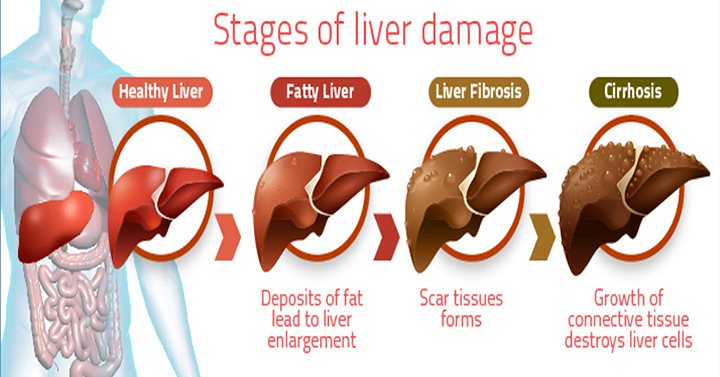Liver cirrhosis is a progressive condition where scar tissue replaces the healthy tissue of your liver, which eventually results in your liver’s inability to function properly. This happens because the scar tissue prevents the flow of blood through the liver and slows the processing of nutrients, hormone, drugs, and toxins that are produced naturally. Liver cirrhosis is the 12th leading cause of death by disease. Here is an overview of the stages of liver cirrhosis.
1. Healthy Liver
Your liver begins as a healthy liver that is able to help fight infections and clean your blood. It can also help with food digestion and stores energy for when you need it. At this stage, your liver can grow back (regenerate) when it is damaged.
2. Inflammation
Your liver may become inflamed in the early stage of liver disease. It can become tender and enlarged. If your liver is inflamed, it means that your body is trying to fight an infection or heal an injury. Inflammation can permanently damage your liver if it continues over a long period of time. An inflamed liver can be difficult to detect because it may not cause you any discomfort, but if the condition is diagnosed in this state and treated, the inflammation has the potential to go away.
3. Fibrosis
The inflamed liver starts to scar and replace healthy liver tissue. This process is called fibrosis. Scar tissue is not able to do the work of healthy tissue and blood flow through your liver can be impaired. Your liver starts to function poorly as more scar tissue accumulates and the healthy part of your liver works harder to compensate for the scarred part.
However, there’s still a chance that your liver can heal itself over time if diagnosed in this stage.
4. Cirrhosis
If your liver becomes severely scarred and is left untreated, it can no longer heal itself. Cirrhosis is the stage when the damage cannot be reversed and can lead to several complications.
Sometimes cirrhosis symptoms are the first signs of liver disease. Symptoms include:
- Bleeding or bruising easily.
- Water building up in your legs and/or abdomen.
- Jaundice, a condition in which your skin and eyes may take on a yellow color.
- Itchy skin.
- Blood backing up because of blockage in blood vessels leading to your liver, possibly causing these blood vessels to burst.
- Increasing sensitivity to medications and their side effects.
- Developing resistance and type-2 diabetes.
- Toxins building up in your brain, causing problems with concentration, memory, sleeping, or other cognitive functions.
After you’ve been diagnosed with cirrhosis, treatment will focus on slowing the progression of your condition and treating the accompanying symptoms. Stopping or slowing the damage to the liver is still possible and preserving healthy tissue is important.
5. Liver Failure
Your liver is losing or has lost all of its proper function. The first symptoms of liver failure are usually nausea, loss of appetite, fatigue, and diarrhea. This is a life-threatening stage of liver damage and requires emergency medical attention.
Featured Image Source: fitnessandpower.com



